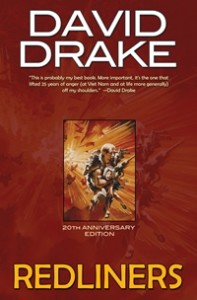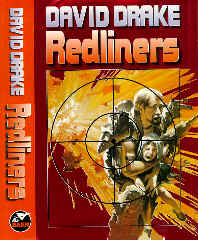A 20th anniversary edition of REDLINERS is out from Baen July 2016 with a new introduction.
Redliners is possibly the best thing I’ve written. It’s certainly the most important thing, both to me personally and to the audience I particularly care about: the veterans, the people who’ve been there, wherever ‘there’ happened to be.
Having said that, Redliners isn’t a book for everybody. It’s very tough even by my standards, and to understand the novel’s underlying optimism you have to have been some very bad places.
I didn’t realize until after I’d written Redliners how many people have been those places. To be perfectly honest, until I came out the other side–as I think I have, pretty much, most days–I didn’t realize how bad the places I’d been were.
The plot germ started when I pitched three ideas to Susan Allison of Ace for a new contract. She chose to have me write a third book in the Lands beyond Pluto (Sir Francis Drake) series, which became Fireships.
The other two ideas were 1) a fairly direct development of the Sumerian legend of Inanna’s journey to the Underworld (in the manner I handled the Norse Eddas in the Northworld series), and 2) a much transformed version of the same myth involving veteran soldiers who entered an environment even worse than what they were used to and who came back out the the other end. Susan quite reasonably said that the Inanna notions offered too much scope to my love of complex plotting.
But that last idea didn’t go away. I got to thinking at a conscious level about the problem of reintegrating veterans into civil society. My own reintegration involved one day being with my unit in Vietnam and 72 hours later sitting in the lounge of the Duke University Law School, waiting to begin my fourth semester after a two-year interruption. Other Nam vets had similar experiences.
Those who stayed in the military were in a differerent situation, one I can’t personally speak to; but the people I served with in the 11th Armored Cavalry Regiment were mostly draftees like me, and even the lifers had to get out some time. What happened then?
I suspect the answer was generally my answer: I kept it between the ditches. I was considered weird in law school but heck, I’d been weird in the army also. (One of the guys in my 6-man intelligence unit [BICC] in Cambodia recently commented that the only thing he remembered about me is that I was always translating Latin.) I was a whole lot stranger for the first five or ten years after I got back than I think was obvious from the outside, but I didn’t let it out in really bad ways. Thank goodness I had my writing (though it added its share of stresses, too).
I think there are better ways to reintegrate veterans than were in place in 1971, but I’m not sure there are any really good ones. My job is fiction, though, not social engineering, so I created a radical solution that could only be imposed by an autocracy as extreme as that of modern-day China. (In passing I’ll note that I wouldn’t care to live in that society; but then, I didn’t much like going to Cambodia in the fashion I did either.)
That’s how the notion came to be. It leaves the question of why I picked an infantry unit rather than tankers like the men I served with in Nam (and who became the basis of my Hammer series).
I wasn’t consciously aware of how I’d made that choice until I put together the collection Grimmer Than Hell (a February, 2003, release from Baen Books). It includes the stories I wrote for The Fleet, a shared universe I co-edited with Bill Fawcett back in the late ’80s. Bill conceived The Fleet as Military SF, but in fact–and properly–most of the stories we bought were space opera.
My own entries in the six volumes were Military SF, however, following the command team of a special operations commando in a war that was about as messy as the one I’d been in. The series was open-ended; I’d thought/hoped it would end with the fourth volume, but it went on for two more. Well, that was real also. My characters behaved like people who knew the war would be over only when they died; and they kept on going, because they were soldiers and that was what they did. When the series did end, the characters were left with no certainty but the one I returned to the World with in 1971: the certainty of their own death.
Fifteen years later I wrote Redliners about a unit very like theirs, fighting a war very like theirs–and I’ve come to realize, very like every war is to the people who fight it. The characters in Redliners got a chance to come back, though; and most unexpectedly, writing the novel allowed me to come back too–pretty much, on most days.
Maybe there could be a better result, but this one’s a great improvement on what I had before.
—Dave Drake

